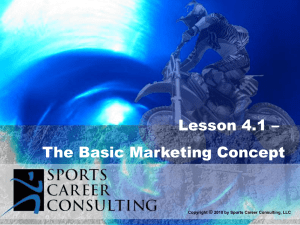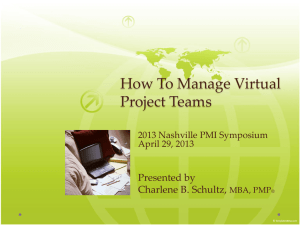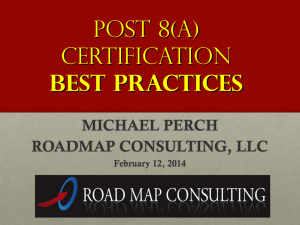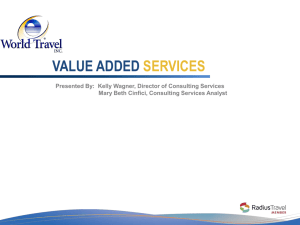Valerie McCloud-Dec.3
advertisement
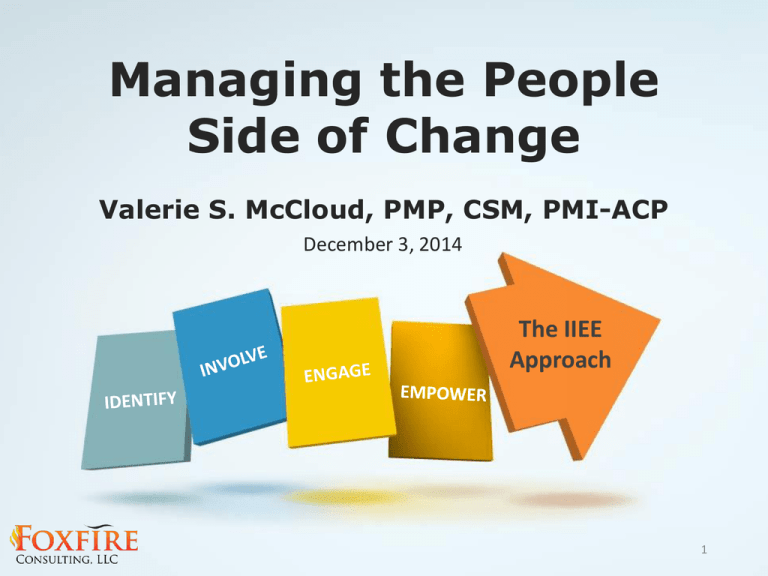
Managing the People Side of Change Valerie S. McCloud, PMP, CSM, PMI-ACP December 3, 2014 The IIEE Approach 1 Presentation Topics © Copyright Foxfire Consulting, LLC 1 Making a Case for Change Management 2 Challenges of Change Management 3 The IIEE Approach to Managing Change 4 New Ways to Think About & Implement Change 5 Resources to Adopt Change 2 Making a Case for Change Management “It is not the strongest of the species that survives, nor the most intelligent that survives. It is the one that is most adaptable to change.” – Charles Darwin “We now accept the fact that learning is a lifelong process of keeping abreast of change. And the most pressing task is to teach people how to learn.” – Peter Drucker © Copyright Foxfire Consulting, LLC 4 Making a Case for Change Management What is change management? Change management is a structured approach to transitioning individuals, teams and organizations from a current state to a desired future state. © Copyright Foxfire Consulting, LLC 5 Making a Case for Change Management The literature on “change management” is clear: Over 70% of change initiatives fail. • John Kotter’s 1995 published research - only 30% of change programs are successful. In 2008, a McKinsey & Company survey – still 30% success rate. • The IBM recently published a report: Making change work…while the work keeps changing – only the top 20% of organizations were highly successful. • Prosci's 16 years of research - projects are six times more likely to meet objectives when organizations manage the people side of change effectively. Myth: A great idea/solution + Effective project management = Project Success © Copyright Foxfire Consulting, LLC 6 Making a Case for Change Management Change Management as a discipline, has grown tremendously. A 2005 Benchmarking study - structured approach to managing change grew from 34% to 55%, and it has continued its growth. Importance of managing change: • More and frequent changes – Change happening at incredibly fast pace. Organizations need better way to manage individuals impacted by many changes. • Value system of empowerment – Old values of control and predictability given way to new values that push decision-making, authority and responsibility down into the organization. • Competitive advantage – Information moves quickly and across the globe in literally seconds! In coming years, speed and agility will be a central differentiator in the marketplace. Companies no longer have luxury of expecting day-to-day operations to fall into static, predictable patterns interrupted only occasionally by short bursts of change. Instead, constant change has become the new normal. 7 © Copyright Foxfire Consulting, LLC Making a Case for Change Management In Prosci's Best Practices in Change Management 2014 Edition benchmarking report - 9 top trends expected over the next two years: 1. 2. 3. 4. 5. 6. 7. 8. 9. Greater awareness of the need for change management Broader application of change management Increased leadership support for change management Greater effort to establish a Change Management Office (CMO) or dedicated functional group Increased use of methodologies, tools to manage the people side of change Greater emphasis on training, communications and reinforcement plans Increased focus on impacted individuals Recognition of the need for change portfolio management More engagement and earlier integration with project management © Copyright Foxfire Consulting, LLC 8 1 Making a Case for Change Management Why Change Management? When change is NOT managed… When change is effectively managed… • • • • • • • • • • • • Productivity declines – people more concerned with change Passive resistance festers; active resistance emerges & sabotages efforts Valued employees leave the organization People confused about change and why it’s happening Increased absenteeism, use of sick days People find work-arounds to avoid implementing new way Changes not fully implemented or cancelled altogether Divides created – ‘us’ vs. ‘them’ Sensitivity to change creating increased resistance Loss of goodwill; increased customer dissatisfaction due to service decline/delivery Lack of confidence in management’s capabilities and decisions © Copyright Foxfire Consulting, LLC • • • vs • • • • • Employees have a solid understanding of why change is happening Employees engage in both the solution and the change Resistance decreases & is dealt with earlier in the process Leadership commitment, participation and interaction will motivate employees to support the process Communications are segmented to specific audiences answering questions cared about most Momentum is built throughout organization Changes are less painful Increased probability of meeting objectives Once change is properly managed, productivity will boom 9 Making a Case for Change Management The Nature of Change Planned Change Moving from one state to another using a structured set of steps. Emergent Change Fluid and emerging; it’s all pervasive and continuous. Naturally occurring. • Organization’s environment known • Facilitate one condition to another • Need to be responsive and adaptive • Change is constant Implications for recognizing change from differing perspectives: • Managing change is about managing a process, using appropriate approaches based on the nature of the change. • Change models should be applied selectively, with thought to best fit for context in which change is occurring. © Copyright Foxfire Consulting, LLC 10 Making a Case for Change Management The more the word “change” grows in importance, the more that the the desired future state includes enduring changes in human behavior and attitudes. © Copyright Foxfire Consulting, LLC 11 Making a Case for Change Management IBM Institute of Business Value: Making change work…while the work keeps changing: How Change Architects lead and manage organizational change - 2014 © Copyright Foxfire Consulting, LLC 12 Making a Case for Change Management IBM Institute of Business Value: Making change work…while the work keeps changing: How Change Architects lead and manage organizational change - 2014 © Copyright Foxfire Consulting, LLC 13 Challenges of Change Management “We have to change because…and look at all the benefits we’ll achieve!” Two Views of Change: Organizational Change Management • From top looking down into the organization Senders Business issues and need to change “I may not have a job. The company’s in trouble! What’s happening to me…?” Receivers Personal implications and risk Individual Change Management • Perspective of change from the employees © Copyright Foxfire Consulting, LLC 15 Challenges of Change Management 3 major reasons why change fails: 1. The gap between the strategic vision and implementation; 1. The "hidden and built in resistance to change" from organizational cultures; 1. Failure to take full account of the impact of the changes on those people who are most affected by them. © Copyright Foxfire Consulting, LLC 16 Challenges of Change Management More reasons why change initiatives fail: • PERCEPTION: Solution offered doesn't resonate with people • MANAGMENT: Program doesn't have the support of top management or, conversely, the program is top-down, packaged program • ENGAGEMENT: People not adequately engaged in the organization • COMMUNICATION: Lack of communication • REALITY: The solution doesn't address the “real” problems • FEAR: A culture of trust is not fostered, so fear persists • RESOURCES: Not properly resourced with time, money, and/or people • TRAINING: Not provided or is inadequate • RESISTANCE: Change initiative is resisted by managers, supervisors, others • EFFICACY: The program doesn't work • SUSTAINABILITY: Innovation works, but organization cannot figure out how to implement and sustain it as an organizational change © Copyright Foxfire Consulting, LLC 17 Challenges of Change Management Losses New Vision Confusion The “Gap” • • • • Defines who we are, our success Is comfortable Is predictable Personal and professional plans based on • • • • • “Grey space” “No man’s land” “In limbo” “Between two trapezes” “Nothing to hold on to” • • • • • Not fully defined Lots of uncertainty Starting something new Is worrisome May not match personal and professional goals According to Bridges, people don’t have trouble with change – they have trouble 18 with transition. © Copyright Foxfire Consulting, LLC Challenges of Change Management “It’s not so much that we’re afraid of change or so in love with the old ways, but it’s that place in between that we fear… It’s like being between trapezes. It’s Linus when his blanket is in the dryer. There’s nothing to hold on to.” - Marilyn Ferguson © Copyright Foxfire Consulting, LLC 19 Challenges of Change Management Understanding Resistance We react to change based on our view of the current state and the future state. • Our analytical reaction is based in the future state. • Our emotional reaction is rooted in the current state. Supportive of the current state: has time and energy invested in how things are done today Supportive or comfortable with current state Dissatisfied, or opposed to the current state Neutral or objective toward the current state Is neutral toward the current state: Is new to the organization or is indifferent to how things are done today © Copyright Foxfire Consulting, LLC Opposed to the current state: is dissatisfied with the way things are done today 20 Challenges of Change Management Understanding Resistance Personal Context Organizational Context Positive and negative factors are evaluated by employees: These positive and negative motivating factors also evaluated: • Employee’s personal and family situation (health, finances, stability, mobility, relationships, etc.) • Organization’s history with change (past change successes or failures, likelihood of change actually happening, consequences for employees that have resisted change in the past) • Employee’s professional career history and plans (success vs. failure, promotions, aspirations, pending retirement, etc.) • Degree that the change will affect them personally (some large changes may have minimal impact and vice versa) © Copyright Foxfire Consulting, LLC • Organization’s values and culture (how the organization treats employees and how employees treat each other) • Degree of trust that exists between managers and employees 21 Challenges of Change Management Reasons for Resistance Employees: • Lack of awareness of why change is needed • Uncertainty (creating stress…fear) • Impact on current job role • Lack of visible support and commitment from managers, leaders • Fear of job loss • Organization’s past performance with change © Copyright Foxfire Consulting, LLC Managers: • Lack of awareness about and involvement in the change • Loss of control or negative impact on job role • Increased work load (lack of time) • Culture of change resistance and past failures 22 Challenges of Change Management Change Concepts • Resistance is a natural human reaction to change. • You should expect resistance and not be surprised by it. • Resistance should not be considered as initially “bad”. • Resistance may be leveraged. © Copyright Foxfire Consulting, LLC 23 Challenges of Change Management Stage 3: Chaos Group enters the unknown. Old expectations no longer be valid; old reactions may cease to be effective; and old behaviors may not be possible. Satir Change Model Stage 4: Integration Members discover a transforming idea that shows how the foreign element can benefit them. Stage 1: Late Status Quo Stage 2: Resistance Stage 5: New Status Quo Group at familiar place. Members know what to expect, how to react, and how to behave. Group confronts a foreign element (that threatens stability). Resistance by denying its validity, avoiding the issue, or blaming someone for causing the problem. If the change is well conceived and assimilated, the group and its environment are in better accord and performance stabilizes at a higher level than in the Late Status Quo. © Copyright Foxfire Consulting, LLC 24 Challenges of Change Management Emotional Stages of Change • People move through the emotional stages of change at different rates. • When people are in denial, or are angry or resistant, productivity will be low. • Design and plan strategy to recognize and support the transition phase and gain commitment. Commitment Reluctant acceptance Anger and blame Disbelief and denial © Copyright Foxfire Consulting, LLC 25 Change Management Methodologies • George Box, a statistician, famously wrote that "essentially, all models are wrong, but some are useful” . The field of change management continues to prove him right. • Organizational change management (OCM) is a structured approach to ensure that changes are smoothly and successfully implemented, and that the lasting benefits of change are achieved. That is easier said than done. • Management consultants, clinical psychologists and social scientists have done extensive research on the dynamics of change and proposed models and frameworks to understand the same. • Following is a comparison of five popular models. © Copyright Foxfire Consulting, LLC 26 Kotter’s Eights Steps to Change John Kotter’s (1996) - highlighted eight key lessons which he converted into a practical eight-step model. Establish a Sense of Urgency Form a powerful, guiding coalition Develop a vision & strategy Communicate the vision Remove obstacles & empower action Plan and create short-term wins Consolidate gains Anchor in the culture 1. 2. 3. Benefits Focus on buy-in of employees as the focus for success Clear steps which can give guidance for the process Fits well into the culture of classical hierarchies © Copyright Foxfire Consulting, LLC 1. 2. Limitations Top-down approach, it gives no room for co-creation or other forms of true participation Can lead to frustrations among employees if the stages of grief and individual needs are not considered 27 Prosci’s ADKAR Model Developed in 1998 by Prosci. ADKAR is a goal-oriented change management model that allows change management teams to focus their activities on specific business results. 1. 2. 1. © Copyright Foxfire Consulting, LLC Benefits It covers the organizational dimension of change and the individual dimension of change Provides a clear management checklist to manage change Limitations Ignores the need for leadership to address the emotional dimension 28 Roger’s Technology Adoption Curve Based on Everett Roger’s theory of diffusion of innovation (1962), describes the adoption or acceptance of a new product or innovation, according to the demographic and psychological characteristics of defined adopter groups. 1. 2. Benefits Helps in creating an understanding of the audience for change. Provides inputs to identify opinion makers and influencers. © Copyright Foxfire Consulting, LLC 1. 2. Limitations People need not fall into one Change Adoption Category; they drift from category to category depending on the specific change/innovation. The adoption terms are accurate only in hindsight; they tell you nothing about how a population might respond to a change/innovation. 29 Bridge’s Transition Model Bridges (1991) - differentiates between change and transition. Change is situational and happens without people transitioning and transition is psychological and is a three phase process where people gradually accept the details of the new situation. ENDING End what ‘used to be’; identify who is losing what, openly acknowledge the loss, mark the endings and continuously repeat information about what is changing and why. 1. NEUTRAL ZONE Individuals within the organization feel disoriented with falling motivation and increasing anxiety. Ensure that people recognize the neutral zone and treat it as part of the organization's change process. Benefits You can use the model to understand how people feel as you guide them through change. It clarifies the psychological effect of change. © Copyright Foxfire Consulting, LLC NEW BEGINNING Gain acceptance of the purpose; Communicate a picture of how the new organization will look and feel ; Communicate and gain a step-by-step understanding of how the organization will change 1. Limitations While the model is useful for implementing change, it's not a substitute for other change management approaches. It can’t be used as an independent change management model. 30 McKinsey 7S Model Tom Peters and Robert Waterman (early 1980s) seven internal, interdependent aspects of an organization that need to be aligned if it is to be successful. The company's structure, strategy, systems, style, staff and skills all stem from why the organization was originally created, and what it stands for. As the values change, so do all the other elements. 1. 2. 3. 4. Benefits Effective method to diagnose and understand organization Provides guidance in organizational change Combines rational and emotion components All parts are integral and must be addressed in unified manner © Copyright Foxfire Consulting, LLC 1. 2. 3. Limitations When one part changes, they all change because they are all interrelated The model is complex Can lead to higher incidence of failure due to complexity 31 The IIEE Approach to Managing Change Change Readiness “Creating readiness involves proactive attempts by a change agent to influence the beliefs, attitudes, intentions and, ultimately, the behavior of a change target. At its core, the creation of readiness for change involves changing individual cognitions across a set of employees…it is a precursor to either resistance or support for change.” - Achilles A Armenakis, Stanley G. Harris and Kevin W. Mossholder, Chapter 28, Organizational Development and Transformation © Copyright Foxfire Consulting, LLC 33 The IIEE Approach to Managing Change Questions to Ask Before Change • What do we need to achieve? • Why? How? When? • Who will be affected? • How will they react? • How do we support them? • Do we have the resources to manage the change? • How do we communicate the change and get buy-in? • How do we deal with resistance? • What part of the change do we need help with? • How do we know what success is and how will we measure it? • After the change, what next? © Copyright Foxfire Consulting, LLC 34 IIEE Approach to Managing People Side of Change Identify Empower IIEE Approach Involve Engage © Copyright Foxfire Consulting, LLC 35 IIEE Approach to Managing People Side of Change Identify Stakeholders are people who have some form of interest in the change, whether they are the targets of the change, managers or other interested parties. A lack of stakeholder management is one of the key reasons why change projects fail, so understanding them and ensuring they are addressed in all plans and activities is a critical activity. It is important to manage stakeholders in change. In doing so, one of the things you will do is segment them according to their needs, their importance and how you will treat them. © Copyright Foxfire Consulting, LLC 36 IIEE Approach to Managing People Side of Change Types of Stakeholder Sponsors People with power who have a direct interest in the project. Targets People who will intentionally be affected by the change. Others Other people who may be unintentionally affected by the change, e.g., process change impacts everyone connected with its inputs & outputs. Partners Internal and external partners you work with to effect the change, from the IT Department to external consultants and trainers. Interested Party People who might have some more distant interest, e.g., if there are going to be job losses, then government and the media may have an interest. © Copyright Foxfire Consulting, LLC 37 IIEE Approach to Managing People Side of Change Researching Stakeholders An important part of making change successful is to understand the stakeholders, who can range from a janitor at the bottom of the tree to a CEO of a multinational company. Here are a few ways you can find out more about these people. © Copyright Foxfire Consulting, LLC One-onone interviews Surveys Focus Groups Things others say about them… 38 IIEE Approach to Managing People Side of Change This Influence/Interest Grid is a useful map to help understand the need for communication and potential resistance to change. High Keep Satisfied Actively Engage Low Influence 'Interest' indicates their likely concern about change, whilst 'Influence' indicates their ability to resist or champion the change. Occasionally Contact Keep Informed High Low Interest © Copyright Foxfire Consulting, LLC 39 IIEE Approach to Managing People Side of Change Stakeholder Power Stakeholders all have power, whether it is the formal power invested in a position of authority or it is social power of being able to persuade others to support or oppose the change. Those with higher power are likely to be your most useful supporters or most dangerous opponents -- thus stakeholder analysis helps you prioritize your focus on stakeholders and map out strategy to influence. © Copyright Foxfire Consulting, LLC 40 IIEE Approach to Managing People Side of Change Involve Involving employees and managers means communicating – messaging and relating. What employees want to know about about the change initiative. • • • • • • How will I be impacted? Why is the change happening? What is changing? How does it impact the organization? And what I do? How can I prepare for the change? How will I be supported during the change and beyond? © Copyright Foxfire Consulting, LLC 41 IIEE Approach to Managing People Side of Change Communication • Communicate, Communicate, Communicate • Most change processes are under-communicated by a factor of ten • Many media/channels, same message • Many spokespersons, same message • Many formulations, same message • Relate: To form a new emotional relationship with a person or group • Repeat: How the new relationship helps you learn and practice and master new habits and skills • Reframe: Learn new ways of thinking about the specific change situation Be sure to provide employees ways to give feedback and ask questions. © Copyright Foxfire Consulting, LLC 42 IIEE Approach to Managing People Side of Change Target Frontline Supervisors for Message Delivery • 83% of employees rank their supervisor as their most believed source. – U.S.: General Motors • 96% of frontline employees believe their supervisor is normally or always telling the truth. – Australia: Dennis Taylor • Employees say their immediate boss is their most effective communication source. – Europe: International Research © Copyright Foxfire Consulting, LLC 43 IIEE Approach to Managing People Side of Change Engage Employee Needs for Engagement When you are working to engage employees and encourage participation, you must begin building Awareness of the need for change so your employees are in the right place to engage and participate. 1. Make a clear and compelling case for the need for change 2. Create deliberate opportunities for employees to engage in the change, early and often 3. Define and measure engagement and adoption © Copyright Foxfire Consulting, LLC 44 IIEE Approach to Managing People Side of Change Employee Needs for Engagement 1) Control (involvement and empowerment), 2) Career (understanding of one’s path), 3) Capability (training and development)—are important Employees undergoing change appear to have significantly more need for a fourth ingredient, connection: Connection with leaders—Employees want more two-way dialogue with organizational leaders Connection with co-workers—Employees need to see their coworkers pulling together, providing reliable support and making personal sacrifices during uncertain times © Copyright Foxfire Consulting, LLC 45 IIEE Approach to Managing People Side of Change Levels of Engagement © Copyright Foxfire Consulting, LLC 46 IIEE Approach to Managing People Side of Change Six Actions to Create More Engagement 1. Communicating a clear vision of the future 2. Building trust in the organization 3. Involving employees in decisions that affect them 4. Demonstrating commitment to the company’s values 5. Being seen to respond to feedback 6. Demonstrating genuine commitment to employees’ well being © Copyright Foxfire Consulting, LLC 47 IIEE Approach to Managing People Side of Change © Copyright Foxfire Consulting, LLC 48 IIEE Approach to Managing People Side of Change Empower © Copyright Foxfire Consulting, LLC 49 IIEE Approach to Managing People Side of Change Barriers to Empowerment Formal structures make it difficult to act Bosses discourage actions aimed at implementing the new vision Employees understand the vision and want to make it a reality, but are boxed in A lack of needed skills undermines action Personnel and information systems make it difficult to act © Copyright Foxfire Consulting, LLC 50 IIEE Approach to Managing People Side of Change Empowered employees are change-ready employees Apply these strategies and guidelines to empower your employees: • • • • • • • • • Encourage and demonstrate innovative thinking Show respect for others’ perspectives and ideas Delegate; don’t micromanage Extend trust and assume that others have the company’s best interests at heart and genuinely want to help Be flexible, and encourage flexibility in others Demonstrate and encourage risk-taking, and look for lessons learned Accept change yourself Invite people to participate in change development and implementation Track and report progress on change initiatives Empower employees to take responsibility for adapting to change! © Copyright Foxfire Consulting, LLC 51 New Ways to Think About & Implement Change Discontinuous versus Continuous Incremental Change “We are moving from episodic to continuous change. With this shift, urgency will move from being an important issue every few years to being a powerful asset all the time.” - Kotter © Copyright Foxfire Consulting, LLC 53 New Ways to Think About & Implement Change Connecting Change Management to Project/Organizational Outcomes The Prosci ROI of Change Management Model presents three people side factors that impact the return a project or initiative delivers: Speed of adoption - how quickly employees adopt a change Ultimate utilization - how many employees eventually adopt the change to how they do their jobs Proficiency - how effective employees are once they've adopted the change An alternative view… © Copyright Foxfire Consulting, LLC 54 New Ways to Think About & Implement Change Lean & Agile Applied to Change Management • Combining a collection of lean and agile practices to more effectively manage organizational change that is relevant in today’s fast-paced, digital work. Includes: • “Lean Coffee” • Creating and Using Information Radiators • Culture Hacking • Agile Retrospectives • Lewin’s Force Field Analysis © Copyright Foxfire Consulting, LLC 55 New Ways to Think About & Implement Change Enterprise Change Management Below are some of the most cited activities for deploying change management across the organization (in rank order): 1 Train people in the organization 2 Create a change management group 3 Integrate change management with project management 4 Select a common approach for the organization 5 Assign change management resources to projects 6 Implement measurement mechanisms 7 Initiate change management at project launch 8 Mandate the use of change management 9 Enlist senior leadership support 10 Attach change management to particular projects © Copyright Foxfire Consulting, LLC 56 © Copyright Foxfire Consulting, LLC 57 Resources • Harvard Business Review Magazine – Winter 2014: Leading Change: What Works & What Doesn’t • Change Management: The People Side of Change – Jeffrey Hiatt & Timothy Creasy, 2013 • Change Management: The New Way : Easy To Understand; Powerful To Use – Dutch Holland, PhD • Making Sense of Change Management: A Complete Guide to the Models Tools and Techniques of Organizational Change... - Esther Cameron and Mike Green • Prosci Benchmarking Report & Online Tutorials • Leading Change – John P. Kotter, 1996 • Influencer: The New Science of Leading Change – Joseph Grenny, Kerry Patterson, David Maxfield, Ron McMillan, Al Switzler, 2013 • IBM’s Report: Making change work…while the work keeps changing: How Change Architects lead and manage organizational change – September 2014 • Lean Change Management – Jason Little, 2014 • ADKAR: A Model for Change in Business, Government and Our Community – Jeffrey Hiatt, 2006 59 © Copyright Foxfire Consulting, LLC THANK YOU Valerie McCloud, PMP, CSM, PMI-ACP President, Emergent Change Agent Foxfire Consulting, LLC www.foxfireconsulting.net 804.240.0148 Connect with me on LinkedIn! 60 The Process of Transition © Copyright Foxfire Consulting, LLC 61
